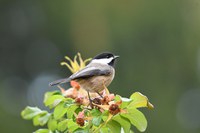Dakota Gardener: Landscaping is for the birds
(Click an image below to view a high-resolution image that can be downloaded)
By Emily How, Horticulture agent
NDSU Extension – Ward County
Growing up, I spent a lot of time with my grandmother. One of our favorite activities was watching the birds that would come to her feeder every morning. This year, I have been landscaping to attract more birds to my yard.
Birds require three things to survive - food, water and shelter. Food is easily provided in the form of bird seed and bird feeders, but other forms of food can also be provided. For instance, if there are damaged vegetables in your garden, you can place them in an open area away from the garden; this provides food for the birds and helps keep them out of the rest of the vegetables in the garden.
You may also choose to plant a sacrificial crop. Additionally, if there is a certain fruit, such as Juneberries or Haskaps, that you want to protect from the birds, you can cover that plant with a densely woven net while leaving a less desirable fruit, such as a wild grapevine, for the birds.
Attract birds with the sound of moving water; think streams, lakes and ponds. However, having a pond in your backyard is not really an option for everyone, including me. There are some simpler options that can be equally effective. One method uses a plastic gallon-size bottle hung over a basin to collect water. Simply puncture a small hole in the bottom of the bottle, fill with water, and hang from a tree branch or other high spot over a bird bath or shallow dish. The bottle will slowly drip into the basin and provide a moving water source for the birds.
A more beautiful option would be to use a solar-powered bird bath fountain. Be sure to place a large rock or structure in your bird bath to provide a landing spot and refill the water often. Cleaning out your bird bath once or twice a year is required, but do not use bleach! Bleach can remove the natural oils from the birds’ feathers and is toxic to the birds. Hot water and good scrubbing are sufficient.
Building a shelter can require a little more time and thought. Work with what you have and know that different birds prefer different shelters. If you are interested in attracting a certain type of bird, know what type of shelter they prefer. Black-capped Chickadees, for example, prefer to shelter in cavities of trees with soft, decaying wood; in the yard, use a nest box filled with wood shavings.
Another option is to plant shrubs and trees that act as both a shelter and a food source; crabapples, oaks and conifers are great options. Other native plants such as milkweed, Black-Eyed Susan and ornamental bluestem provide food and shelter for birds and, as a bonus, color and texture in the landscape.
Now that you have attracted the birds into your landscape, you can reap the benefits. Having birds in your landscape helps lower insect populations, aids in pollination and increases mental health. Yes, watching the birds in your yard increases mental health, as well as lowers blood pressure and other stress-inducing hormones.
Want the benefits of birdwatching, but don’t have a yard? The Cornell Lab of Ornithology (study of birds) has a Citizen Science Project in which you watch a bird feeder, count the birds that visit and submit the results on their website.
This summer, do some landscaping for the birds…and in turn, yourself!
NDSU Agriculture Communication – June 26, 2025
Source: Emily How, 701-857-6444, emily.how@ndsu.edu
Editor: Kelli Anderson, 701-231-6136, kelli.c.anderson@ndsu.edu




